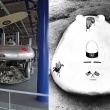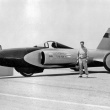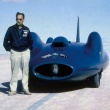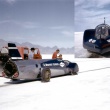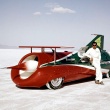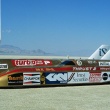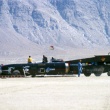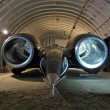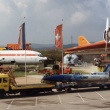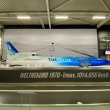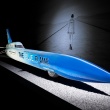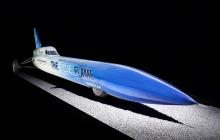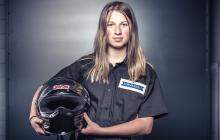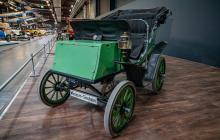It is eleven metres long, steel-blue, and resembles a rocket – only the wheels indicate that it could be a car. On October 23rd, 1970, the American Gary Gabelich drove faster than 1,000 kph in this rocket vehicle and thereby set a new land speed record. The rocket, known as “The Blue Flame”, has been exhibited at the Technik Museum Sinsheim for over 30 years. On the exact same day 50 years later, a man – who is quite familiar with the Blue Flame and with speed – visited us: Thomas “Pork Pie” Graf – he is one of five globally recognised historians for speed records. However, he is also the only contemporary witness: equipped with a camera, he was at the scene as the record attempts took place. Afterwards, he gave us this exciting report: the Blue Flame – a record vehicle that had the potential but not the permission...
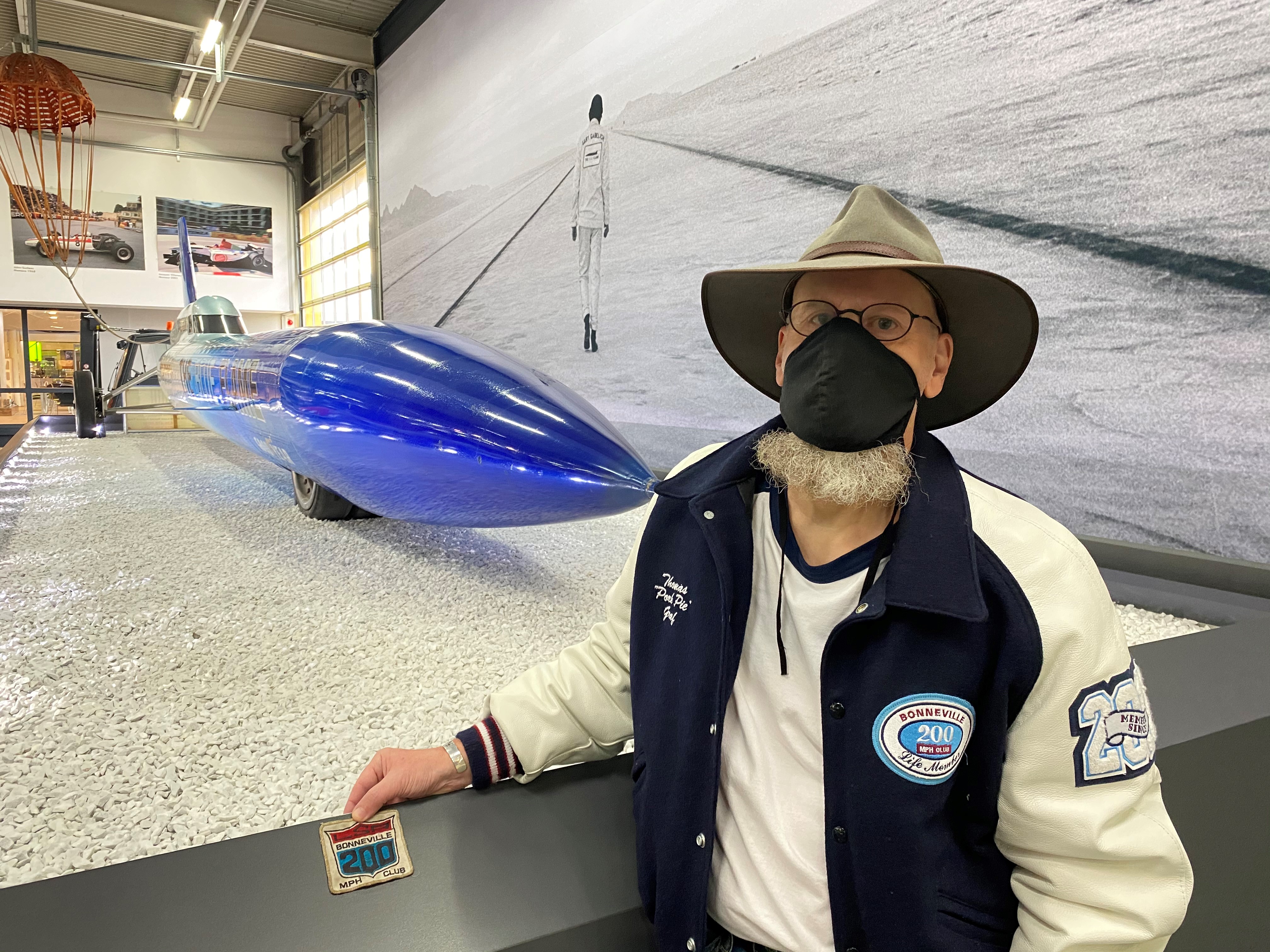
October 23rd, 1970, was a very special day in the history of speed record attempts... for me as well, by the way. 50 years ago today, Gary Gabelich set a new absolute land speed record in the Blue Flame. The Blue Flame – there is a lot written about her, some of it is known. However, there are some unknown facts and stories I would like to talk about.

In 1965, when three young enthusiasts had the idea of finding a new way to reach the highest possible land speed, a revolution had just taken place in the world of record attempts. In a short time, speed reached a level no one would have even dreamt of a few years before. Those three – Dick Keller, Pete Farnsworth and Ray Dausman – came to the conclusion that all previous record vehicles had been terribly bulky from an aerodynamic point of view and that the only true drive could be a rocket engine.
In order to prove their theory, they initially built a small rocket engine that wasn’t bigger than the palm of a hand. However, it was impossible to convince sponsors with this prototype, so they built the X-1, the first successful dragster with a rocket engine that continuously set new records on the quarter-mile. As a result, sponsors were impressed, Reaction Dynamics was founded, the Blue Flame was built and the rest is history...
So, what’s so special about it?
Let’s have a look at the previous years. Until the beginning of the 1960s, the absolute speed record was easy to reach. The FIA, the International Automobile Federation, and the FIM, the International Motorcycling Federation, prescribed the following regulations: none. You could use whatever you wanted. The only condition was that you had to be fast enough on the flying mile or the flying kilometre within one hour and in opposing directions – and be one percent faster than the previous record (this one-percent-rule was abolished in 2011). That is why, in the 1930s, new records were set with large-volume engines from propeller planes. As of 1947, John Cobb held the record in his Railton Special. In one direction, he was the first one to exceed 400 mph. The record was set at 394 mph (about 635 kph). For many years, no one broke that record.
No one even got close to that speed. In 1960, Mickey Thompson reached more than 400 mph in his Challenger I – unfortunately, only in one direction. The effort, however, was enormous: the vehicle was equipped with four engines with compressors. At the same time, the first innovative ideas came up. Back then, jet engines (thrust drives) were relatively cheap. The first one to be successful with this was Craig Breedlove. In 1963, he set the first record of over 400 mph. The vehicle – if it can actually be called a vehicle in the sense of an automobile is questionable – had three wheels and a jet engine.
The FIA didn’t know how to handle this case at all. The FIM, without further ado, decided to recognise it as a tricycle with a thrust drive and declared it the world’s fastest land vehicle (at 407 mph). That is how it became the absolute record holder for the first time. The chaos was complete when Donald Campbell reached a record of 403 mph in July 1964 in his wheel-driven vehicle with a turbine drive. For the FIA, this one was the new record. The FIA still had to figure out how to categorise vehicles with reaction engines. Especially since there were plenty of those in 1964: Breedlove’s record was first beaten by Tom Green in the Wingfoot Express of Walt Arfons, then Art Arfons (Walt’s half-brother) was the next one to beat it. Then, it was Craig Breedlove’s turn again. Tom Green was recognised by the FIA (thus the FIA had the fastest land vehicle again). Breedlove still drove his tricycle and got recognised by both the FIA and the FIM – even though his vehicle was missing one wheel! Breedlove was also the first to surpass 500 and 600 mph and thereby became a legend in the history of speed records.
In the end of 1965, the battle between Craig Breedlove and Art Arfons was over for the time being, however, the chaos in the FIA’s and FIM’s record books wasn’t over yet: piston engines competed with turbine engines and jet engines. The FIA solved the problem as follows: as of 1965, they separated wheel-driven records, we call them purists, and thrust-driven records, which set the absolute records. The FIM took a little longer for that. In 1979, when no one knew what was going on anymore, all records were frozen and the categories were rearranged.
Back to the three young men and the Blue Flame.
The trio was of the opinion that all the previous records had only been achieved with pure force instead of aerodynamics. So, the Blue Flame became the first vehicle that was developed scientifically. Previous record vehicles had also been tested in the wind tunnel: in 1927, Frank Lockhart’s Stutz Black Hawk was optimised in the MIT wind tunnel – as a student project at university. Reaction Dynamics was responsible for the construction of the rocket engine. Nothing innovative actually, rather a progress in the development of record vehicles. So why the headline “had the potential but not the permission”?
.jpg)
The rocket engine was originally built as a three-stage engine. After a two-stage combustion start, the engine would have only reached its highest performance at the third stage, with the help of several catalysts – wonderful, if only the tyre manufacturer Goodyear hadn’t existed. Their competitor, Firestone, had retired from record rides after several failures: burst tyres and severe accidents are not good publicity. Goodyear limited the maximum speed to 700 mph for fear of experiencing the same (Breedlove’s record was set at 600 mph). In order to stay under 700 mph, the third stage would have been far too strong according to the data from the wind tunnel. Unfortunately, there was a little problem with the second stage: it only provided 60 percent of the possible performance while also using a lot more fuel than the third stage.
There is a beautiful film about the record ride of the Blue Flame: in the end, Gary Gabelich is celebrated and off-screen, Joe Petrali’s voice announces the new speed record. It’s all just for Hollywood. The film crew had been at the Salt Flats for weeks. Shortly before the winter set in at the Bonneville Salt Flats, the Blue Flame was approaching the record but it still wasn’t fast enough. Hoping that it would work out in the end, the film crew staged a celebration in order to later insert Joe Petrali’s voice – and then they left the Salt Flats and went home.
The problem was the fuel consumption. The solution: in order not to lose too much fuel on the first metres, the Blue Flame was push-started. A little adventurous, considering it had a rocket engine. A Californian from the record scene had the suitable car – a pickup truck on steroids with a slightly modified engine... only slightly! He push-started the Blue Flame and at about 100 mph, he drove to the side and Gary Gabelich started the engine. This happened on October 23rd, 1970. There it was: the new record! What could this vehicle have achieved at the third stage? Goodyear had been fundamentally mistaken. The set of tyres was used for all rides. One tyre had to be replaced because it got damaged while manoeuvring the Blue Flame. For the Americans and everyone else who thinks in miles, it was just another record over 600 mph. In kilometres, it’s a different story: 1,001 kph on the mile and 1,014 kph on the kilometre (in 1970, a sports car driving 200 kph was considered to be fast).
However, the story goes on. We already talked about the chaos at the FIA with the now separated record lists. The FIA made their own life a misery by continuing to change the lists over and over again. In 1983, Richard Noble set a new record – but only on the mile. It wasn’t enough for the kilometre record due to the one-percent-rule. At that point, the category “absolute record” wasn’t separated into jet and rocket engines anymore. In 1997, Andy Green was the first person to exceed the speed of sound and thereby broke the kilometre record of the Blue Flame. A few years ago, the FIA decided to separate jet and rocket engines again, which is why the Blue Flame got its world record back – not the absolute one but the world record. That happened 50 years later... so is it a special record? You bet it is a special record – YES!
For me, October 23rd, 1970, was the start of my career as one of the globally recognised historians for speed records. Without the Blue Flame, I would have never caught the “virus of speed”, as the Americans like to call it, and there’s no cure for that, just records.
Thomas “Pork Pie” Graf
Historian, Photo Artist, Bonneville 200 MPH Club Member
The stories and reports represent the opinions and perspectives of the respective authors. Please note, especially while reading articles about our events, that binding information (e.g. opening hours, admission fees and programme) is only published on the museum's official website www.technik-museum.de.
Please note that the pictures, texts and videos published here are subject to the copyright of the respective authors and / or the museum and may not be used without permission.
Keep up-to-date with new articles
We recommend to subscribe to the museum’s newsletter via e-mail. At the end of each newsletter, we inform you about new articles so that you will not miss any of them. Alternatively, you can subscribe to an RSS feed:
Subscribe to newsletter RSS-Feed (Reader required)

